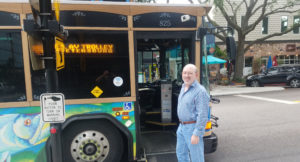By Bob Andelman
November 6, 2006
(I wrote this story for Poynter.org/NewsU.org after covering a great talk by journalist Leon Dash. The article disappeared from Poynter’s own website, so I have added it here to coincide with Leon’s birthday, March 16. — Bob Andelman)
Tact and tenacity.
Patience and rapport.
Those are the four elements that Pulitzer Prize-winning journalist Leon Dash said a reporter needs in covering children and families. Not that they aren’t important characteristics for investigating any story, but they’re particularly valuable traits in forming relationships and trust for stories that require a higher comfort level than daily deadline work.
Dash won the industry’s ultimate prize in 1995 for explanatory journalism following publication of his eight-part four years in the making reporting on Rosa Lee and her family published by the Washington Post (and later expanded in book form as Rosa Lee: A Mother and Her Family in Urban America). Following his 32-year career at the Post, Dash is now the Swanlund Professor of Journalism at the University of Illinois at Urbana-Champaign. He participated in the Poynter Institute’s first-ever “Covering Children” seminar week and shared tips that helped shape his own highly regarded work.
In reporting his opus on the intergenerational poverty connection, Dash started off with the intention of interviewing 20 men and 20 women across four families. He soon realized that approach was too ambitious and unwieldy, focusing instead on one family and its matriarch, Rosa Lee. She was anchored, caring for her grandchildren because one of her daughters was in jail for selling crack. And she, herself, had AIDS.
“Rosa Lee was in one place and followed a routine,” Dash said, “which made following her easy.”
Of course, nothing this grand in scale is ever “easy.” And Dash struggled from the beginning with an editor who was frightened by his use of the word “underclass” to describe his story. “There was blood on the floor from trying to find a definition that worked,” he recalled.
Dash never lacked the self-confidence and self-assurance to follow his vision of tough stories, something he advocated for reporters in the children and families arena.
“Early in my career I heard a number of reporters talking about being risk takers,” he said. “I always thought that was the way to go. I lived with guerilla fighters in Angola twice. My editors thought I was dead. So taking risks was always something I was willing to do.”
A reporter willing to take risks is often more common than finding an editor with matching backbone, he said. Dash said he was infamous in the business for finding the right advocates for his stories – sometimes side-stepping even the most respected names in the business (including Bob Woodward once) to do the job right.
“I did end runs around editors who I found to be obstacles,” he said. (He didn’t actually advocate anyone following his example, but didn’t discourage that step, either.) “When I picked up on that happening, I would do end runs on them and go to editors who had broader views.”
For Dash, journalism wasn’t a job that he did from 9 to 5 – it was a career.
“I wasn’t in journalism to do lukewarm stories,” he said. “I wanted you to pick up my story and say, ‘Holy shit!” If I hadn’t achieved that, I wasn’t working. I was there to provide you with information that you couldn’t learn any place else.”
Those are some things you need to know about Dash so that his specific advice on reporting and investigating children and family stories could be presented with context.
“I’ve often proceeded on projects on presumptions and all my presumptions were incorrect,” he said. “That was fine because my questions were based on the presumptions. I learned the most by forgetting what I thought I knew. And some things I never knew had always been there but had never been looked at.”
During a study into adolescent childbearing (collected in the book, When Children Want Children: The Urban Crisis of Teenage Childbearing), Dash learned a valuable lesson in humanity. The essence of the study, he initially thought, was finding out why young girls got pregnant.
“When I began, I made the mistake of starting with when the baby was created,” he said. “The girls were very uncomfortable with this question because I punched right into sexuality. Big mistake. They gave me answers that would satisfy a high school guidance counselor. But I didn’t want answers they would give to a counselor.”
Dash recognized the importance of bring tact to an interview, being extraordinarily patient with extremely personal subjects, and yet never losing the tenacity that made his style special and effective.
“I wanted people to get used to my style of interviewing, my curiosity, and to develop a rapport,” he said. “Ask questions based on your own experience and the person you’re interviewing will tell you about their experiences.”
Don’t come to these interviews with a prepared script of interviews; questions for families and children have to be open-ended, he said, much the way a conversation would be.
Some suggestions for breaking the ice:
• Ask about going to church;
• Ask about growing up outside the family;
• Ask about the first time they ran an errand by themselves;
• Ask about their first pair of in-line skates.
“Through that process,” Dash said, “you will reach pubescence, and their interest in boys, in girls. Through that we research sexuality.”
In the case of his adolescent childbearing study, each interview took anywhere from two to four hours.
“By the fourth interview,” Dash said, “I had eight to 16 hours on tape. Collectively, to me, that was interview number one. I would do eight or nine interviews per person. As I went along, the interviews got shorter because people started to contradict what they’d told me. But that’s a happy moment because they start to remove their public mask. When they contradict, I know they’ve grown comfortable enough with me to tell me something.
“I tell my students, ‘You’re not going to get the absolute truth. You won’t find couples married 70 years who tell each other the absolute truth. That’s how they stay married. Your goal is to get as close to the truth as possible. Ours is not an adversarial relationship. This is a process by which you have to get the person to let you in. You only get that by building rapport.”
A big part of relationship building goes beyond smooth talk on the reporter’s part. In fact, early on, what you say isn’t your most meaningful contribution. Your reaction to what the interviewee says in the early stages will set the tone for all conversations that follow – or that don’t.
“They will miss the content of your questions because they’re focused on your eyes and your voice,” according to Dash. “They’re looking for judgment. If you are a judgmental interviewer, they will never let you in. They will not sit there and be interviewed and judged simultaneously. If they know you’re middle class – and 99 percent of reporters are middle class – and they’re not, they will test you to see if you’re judgmental. If they see it in your eyes – the first place they look – they will not trust you.”
What’s the big deal? Why must reporters be impartial in their reactions as well as their final reporting?
“My journalism students are young and think the world is black and white,” Dash explained. “I tell them it’s not. There’s lots of grey. I say, ‘Keep your mask on. If you are offended by something people say, you have to be prepared to handle that without being judgmental. If you’re trying to get a serial axe murderer to talk to you, you can’t be judgmental. Leave your opinions and sneers at the door.’”
Not that it’s always that simple. During the course of the four years he spent with Rosa Lee, Dash had several moments when his subject’s behavior gave him throbbing headaches. It usually happened when he “got on stage,” Dash said, “instead of being in the audience.”
He coped – and learned from the experiences – by writing a letter to his editor every week describing the past week’s events. Later it was helpful to Dash to go back and re-read his letters to better understand where he was at different points in his research.
This topic has to do with the barriers a reporter must erect between himself or herself and a subject in order to establish and maintain separation. At one point, for example, Rosa Lee and her family bought Christmas gifts for Dash. He was in their lives almost every day, a virtual extension of their real family. He had to resist the gifts, which were offered in the spirit of the season, not in an effort to influence his reporting. “I’m here as a reporter,” he reminded the family.” “I’m not your friend.”
On another front, Dash said he never gave Rosa Lee or her family members money, but he did give her rides in his car and did on occasion pay for meals in restaurants. Dash – not his editor – set the boundaries.
“When they came into the project, I told them I would never give them money,” he said. “If they wanted a pack of cigarettes, I would buy them that. If they wanted a meal, I’d buy a meal.”
As for “experts” – often the bane of a reporter’s existence because editors insist on them as the glue that holds together most every story whether they do or not – Dash had his own rule of thumb for their inclusion in research for children and families stories.
“I never interview experts until after I’ve done my reporting,” he said. “Every time I do it this way, the experts end up interviewing me. They’ve never spent as much time with individuals as I have. But we call them experts so we can call them on the phone. That’s for the daily story. If you have time while looking at a social phenomenon, please don’t talk to experts until after you’ve done your real research. You’ll get a very different story from them then. You’re not there to verify their Ph.D. You’re there to go beyond it. At least you should want to. If your editor says, ‘Talk to the experts,’ say you want to talk to the people first. You’ll find a much richer story.”
Leon Dash Facebook • Twitter • Wikipedia • Amazon Author Page • “Rosa’s Story” in the Washington Post

Order ‘Stadium For Rent: Tampa Bay’s Quest for Major League Baseball’ by Bob Andelman, now available in an expanded, updated and illustrated 456-page special edition, available from Amazon.com by clicking on the book cover above!
 The Party Authority in New Jersey, Pennsylvania, Delaware and Maryland!
The Party Authority in New Jersey, Pennsylvania, Delaware and Maryland!


